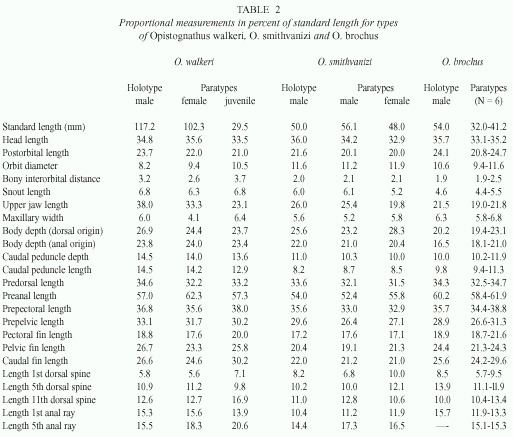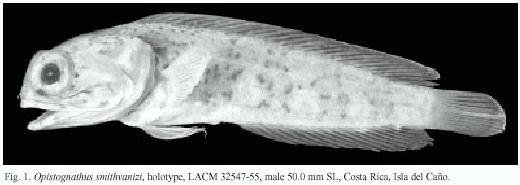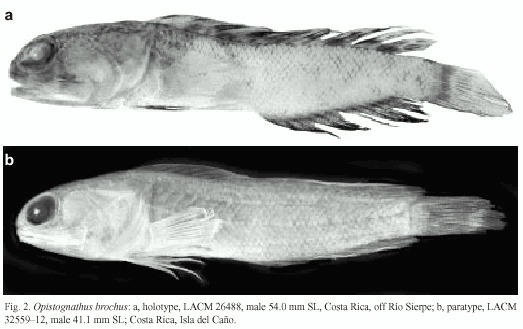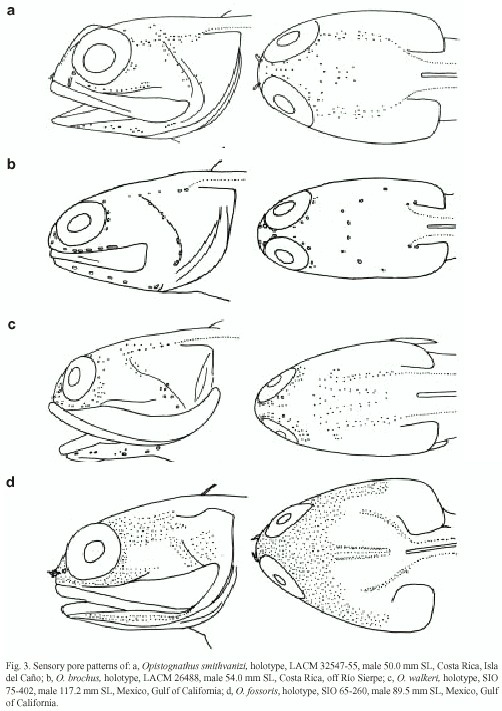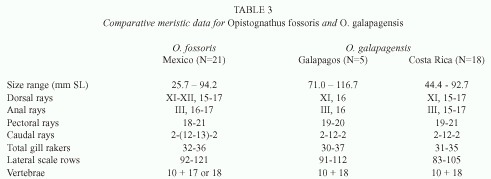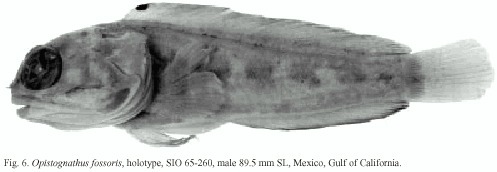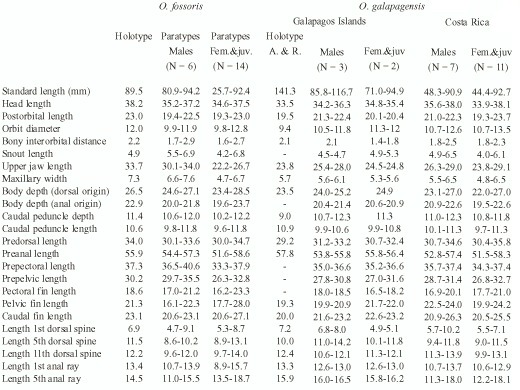Services on Demand
Journal
Article
Indicators
-
 Cited by SciELO
Cited by SciELO -
 Access statistics
Access statistics
Related links
-
 Similars in
SciELO
Similars in
SciELO  uBio
uBio
Share
Revista de Biología Tropical
On-line version ISSN 0034-7744Print version ISSN 0034-7744
Rev. biol. trop vol.51 n.2 San José Jun. 2003
Four new species of eastern tropical Pacific jawfishes (Opistognathus: Opistognathidae)
William A. Bussing 1 & Robert J. Lavenberg 2
Received 27-III-2003. Corrected 24-VI-2003. Accepted 30-VII-2003.
Abstract
Three of four new jawfishes described herein have sexually dimorphic jaws and dichromatic maxillary markings: O. smithvanizi, with a simple nasal cirrus, buccal pigmentation and other traits similar to members of the O. macrognathus group, is known only from Isla del Caño, a continental shelf island off southern Costa Rica; O. fossoris, with a multifid nasal cirrus, a broaddorsal membranous subopercular flap and a black spot on tips of first dorsal-fin spines lives in the Gulf of California and is a sister-species of O. galapagensis; the maxilla of O. walkeri terminates in a flexible scimitar-shaped lamina in adults of both sexes, but is longer in males, the species lacks nasal cirri and is also restricted to the Gulf of California. Opistognathus brochus is a small species with dark speckling on head and body, and several dark blotches along the dorsal fin and two bars on the tail; it is found in moderately deep water on the Costa Rican coast and Gulf of California. Opistognathus mexicanus is placed in the synonymy of O. punctatus. Opistognathus galapagensis, O. rhomaleus and O. fenmutis are recorded for the first time from Costa Rica and a description of the latter is given and an identification key and summary table are provided for all known eastern Pacific species of Opistognathus.
Key Words: New species, new records, jawfishes, Costa Rica, Gulf of California, Galapagos.
Jawfishes are widespread in the eastern Pacific, ranging from the outer coast of Baja California and the Gulf of California south to Colombia, and at the oceanic islands Isla del Coco, Revillegigedos, and Galapagos Archipelago. Prior to 1991 only four nominal species of Opistognathus Cuvier or Gnathypops Gill (a junior synonym) had been described from the eastern tropical Pacific: Opistognathus rhomaleus, O. punctatus, O. ommata and 0. scops, although López and Bussing (1982) listed three other Opistognathus as undescribed species found in Costa Rica, some with wider distributions. Lonchopisthus sinuscalifornicus, the only eastern Pacific member of another valid jawfish genus, was also described by Castro-Aguirre and Villavicencio-Garayzar (1988). This species is now known from the Gulf of California to Colombia and Ecuador, including Costa Rica (López and Bussing 1982). In 1991 Allen and Robertson described four additional new species of jawfishes from the Galapagos Islands, Gulf of California, and the eastern tropical Pacific: Opistognathus galapagensis, O. mexicanus, O. rosenblatti, O. panamaensis. In 1993 Acero and Franke added a tenth species from Gorgona Island, Colombia: Opistognathus fenmutis.
Herein we describe four new species: one of the undescribed Costa Rican species of López and Bussing (1982), an additional Costa Rican species, one from the Gulf of California, the last from the tip of Baja California. A provisional key and summary of principal characteristics for the identification of the species of Opistognathus in the eastern tropical Pacific is provided. We extend the range of Opistognathus rhomaleus to Costa Rica, formerly known only from northern Mexico and the Revillagigedo Islands, and point out two nominal species which we consider synonyms of previously described species. Opisthognathus [sic?] ommata Jenkins & Evermann, 1889 was considered the male of O. scops by Meek and Hildebrand (1928), and thus is a junior synonym, a conclusion with which we concur. We also provide evidence that O. mexicanus Allen & Robertson should be considered a synonym of O. punctatus Peters.
Materials and methods
Anatomical terms, counts and measurements conform to those of Smith-Vaniz (1997) except as indicated below. The number of oblique scale rows commences with the first scale closest to the shoulder girdle, usually at the anterior free margin of the operculum. Some scales have multiple pores, so the lateral-line pore count may be greater than the number of lateral-line scales. Body depth is taken at the vertical from the dorsal-fin origin as well as the anal-fin origin. Measurements were made with pointed dividers and a millimeter rule. Meristic values for holotypes are given in bold type if variation is present.
Most counts were confirmed from radiographs. In material examined, specimen sizes are given as mm standard length (SL); paren-thetical expressions present number of specimens, if more than one, followed by size range. Institutional acronyms follow Leviton, et al. (1985).
Results
Holotype. LACM 32547-55, male, 50.0; Eastern tropical Pacific, Costa Rica, N side Isla del Caño, 8°4315"N, 83°5307" W; substrata rock, coral, and fine sand, moderate surge, ichthyocide station, scuba, 9-15 m, R/V Searcher 472, W. A. Bussing et al.; March 14, 1972.
Paratypes. LACM 32547-56, female, 48.0; data as for holotype. UCR 685-7, male, 56.1; Costa Rica, N side Isla del Caño, 8°4315" N, 83°5307" W; substrata coarse and fine sand, moderate surge, ichthyocide station, scuba, 20 m, R/V Searcher 483, W.A. Bussing et al.; March 17, 1972.
Diagnosis. A small (48-56), robust species of Opistognathus with the following combination of features: Upper jaw sexually dimorphic, maxilla of males longer and with two dark stripes on inner lining; dorsal-fin soft rays, 16 or 17, anal-fin spines III; oblique scale rows in longitudinal series 81-94; gill rakers on lower limb of first arch 22-25; five wide dusky bars overlain with diffuse spotting on body, a faint non-ocellated oval blotch in spinous dorsal between spines 4 and 7; anterior nostril with an unbranched club-shaped cirrus; buccal pigmentation; a large orbit (2.8-3.1 in HL), head short (length 2.8-3.0 in SL), and long upper jaw length (males 1.3-1.4, female 1.7 in HL); caudal vertebrae 19.
Description. Body compressed, head robust; snout blunt, little projecting before eyes (5.7-6.3 in HL), profile almost vertical before eyes, slightly convex from behind eyes to dorsal origin; back slightly elevated; origin of dorsal fin on nape just behind top of gill opening (predorsal length 3.0-3.2 in SL); origin of anal fin slightly behind anus and behind midbody (preanal length 1.8-1.9 in SL). Head profile steep; orbit large, its center over anterior half of upper jaw; interorbital space slightly convex, smooth, less than snout length. Skin texture of head rugose, strongest on snout and along the jaw margins.
Dorsal fin X or XI, 16 or 17; anal fin III, 16; pectoral fin 19 or 20; Caudal fin: procurrent rays 4 + 4-5, segmented rays 8 + 8, middle 12 branched, total elements 24 or 25; fifth hypural present or absent. Vertebrae: 10 + 19; last pleural rib on vertebra 10; epineural ribs 12; one supraneural bone. Gill rakers 10 or 11 + 22-25 = 33-36.
Scales absent on head, anterior portion of nape, area above and in front of pectoral-fin bases, and breast area in front of pelvic-fin bases; area alongside dorsal spines scaled. Oblique scale rows in longitudinal series ca. 81-94, oblique scale rows to terminus of later-al-line pores 40-50. Lateral line terminates below a vertical from base of second segmented dorsal-fin ray. Lateral-line pores 52-62; pores arranged in a single row, arising from an underlying canal through embedded lateral-line tubes. Cephalic sensory pores on top of head numerous, in small clusters and dendritic patterns radiating out from lateral line canals; no pores on operculum; pores on cheek sparse, restricted to mandibulo-preopercular canal; mandibular pores in small discrete patches (Fig. 3a).
Anterior nostril positioned closer to posterior nostril than to margin of upper lip, and consisting of a short tube with a long club-shaped cirrus on posterior rim that extends beyond margin of posterior nostril when depressed; height of tube about equal to half diameter of posterior nostril. Outline of dorsal fin graduated, longer posteriorly; profile relatively uniform without change in fin height at junction of spinous and segmented rays; segmented dorsal-fin rays gradually increase in height; all segmented rays branched. Dorsal-fin spines slender and straight without curved, flexible tips; first or second segmented dorsal-fin and first anal-fin ray unbranched, others branched. Outermost segmented pelvic-fin ray closely bound to adjacent ray, interradial membrane incised distally only; second segmented ray very elongate in both sexes, extending to anus. Dorsal margin of operculum straight, no conspicuous flap present; posterior margin of operculum curved, inclined anteriorly; preopercle partially distinct, with a free margin restricted to the ventral portion.
Jaws subequal, the lower slightly included. Upper jaw sexually dimorphic, extending 0.9-1.2 eye diameters behind orbit in males versus 0.5 in female. End of female maxilla truncate with slightly concave posterior margin; male maxilla with a flexible, scimitar-shaped lamina posteriorly almost reaching border of operculum; supramaxilla present, small, narrow and subterminally positioned. Jaws subequal, lower slightly included. Premaxilla with an outer row of stout canines anteriorly that become progressively smaller posteriorly and extend about one-half length of jaw, to just behind orbit; an inner row consisting of 4-8 recurved canines. Dentary with an outer row of moderate canines, slightly larger anteriorly; an irregular series of slightly smaller teeth behind outer row on anterior half of dentary. Interspaces between tooth rows on both jaws with large papillae. Vomer with a single tooth in males, toothless in the female. Infraorbital bones relatively wide, without moderate openings for sensory canals; third infraorbital without a suborbital shelf or extension.
Color. In alcohol, head and body tan above fading to cream below, top of head with brown reticulations, sides with brown mottling lying over five wide bars beginning just behind pectoral fin base, ending before caudal peduncle and extending onto dorsal fin (Fig. 1). Dorsal fin dusky, a faint non-ocellated oval blotch in spinous dorsal between spines 4 and 7, numerous white spots that line up to form irregular streaks; anal fin mostly dusky, with border darker and a light streak along base; caudal fin dusky with a light area above and below midline at base and two narrow light bars on middle third.
A series of faint bars with light centers radiating downward from eye, first bar running across nostrils onto second under anterior third of eye, directly below dark spot on iris, next under posterior third of eye, fourth running down and back from lower rear margin of eye. All bars continued on upper lip, lower lip with dark marks more of less lined up with markings of upper lip. A diffuse dusky band across chin continuing back along mandible. Edge of bran-chiostegal membrane dark in males, unmarked in female. A small, but prominent dark spot at rear border of eye just below mid-line. Iris silvery overlain with pigment, which may form irregular radiating marks, a black blotch on ventral margin of eye. Males with inner lining of maxilla and adjacent membranes with two dark stripes visible externally, lacking in female.
Inside of mouth with contrasting black and white coloration. Upper oral valve dusky, the lower one with dusky alternating with pale areas as on lips. Tongue unpigmented; copula, basibranchials and ceratobranchials brilliant white. Roof of mouth plain, bases of upper pharyngeal tooth pads white. Ajet-black blotch on each side of esophageal opening widely separated by a pale median area that continues between upper pharyngeals (Fig. 4a). Life coloration unknown.
Size. Known only from the type series, 48.0 (a ripe female), 50.0 and 56.1 mm.
Distribution. Known only from the type locality, Isla del Caño, a small continental shelf island off southern Costa Rica. All individuals taken by scuba-techniques with ichthyocide between depths of 9-20 meters on rocky/sandy substrata. Opistognathus smithvanizi is an eastern Pacific endemic, distributed on the central portion of the Cocos plate.
Etymology. Named in honor of William F. Smith-Vaniz, in recognition of his wide variety of studies, especially dealing with carangids and for setting the standards for the systematic treatment of opistognathids.
Remarks. Smith-Vaniz (1997) included three eastern Pacific Opistognathus (scops, punctatus and one undescribed species) with five Atlantic species in his O. macrognathus species group. The undescribed form is O. smithvanizi, a species which shares a series of features with members of this group such as: sexually dimorphic maxillae, a simple cirrus on anterior nostril, buccal pigmentation, tube-like infraorbital bones, a dark spot on spinous dorsal fin (in this case, very faint), absence of hypural 5 (in this case, variable), and other osteological traits.
TABLE 1
Summary of selected characters in eastern Pacific species of Opistognathus
Counts or features in parentheses are exceptional values
| Chraracters | fossoris | galapagensis | scops | smithvanizi | punctatus | walkeri | fenmutis | brochus | rosenblatti | panamaensis | rhomaleus |
| | |||||||||||
| Dorsal fin | XI(XII),15-17 | XI, 15- 17 | XI(XII),16-17 | (X)XI,16-17 | XI, 16- 17 | XI,12 (13) | XI, 13 | XI, 13 | XI, 13- 14 | XI, 13- 14 | XI,12-14 |
| Anal fin | III, 15- 17 | III, 15- 17 | III, 15- 17 | III, 16 | III, 16- 17 | III,11 (12) | III, 13 | III, 12 | II, 13- 14 | II, 13- 14 | 11,13 |
| Vertebrae | 10+( 17) 18 | 10+ 18 | 10+ 18- 20 | 10+19 | 10+19-20 | 10+16 | 10+16 | 10+16 | 11+17 | 11+17 | 10+18 |
| Hypural 5 | absent | abs. (pres.) | absent | abs. (pres.) | absent | present | present | present | present | present | present |
| Oblique scale rows | 92- 121 | 83- 112 | 132- 145 | 81-94 | 128-152 | 61-62 | 102-105 | 49-57 | 65-70 | 76-78 | 100-105 |
| Total gill rakers | 32- 36 | 30- 37 | 34- 36 | 33-36 | 41-49 | (31)38-39 | 41-47 | 23-27 | 34-35 | 37 | 28-33 |
| Cirrus on anterior nostril | multifid | multifid | simple | simple | simple | absent | absent | absent | absent | absent | simple (short) |
| Vomerine teeth | 1 or 2 | 1 or 2 | 2 | 1 | 2 | 2 or 3 | 9 | 1 or 2 | absent | 1-4 | 2-4 |
| Maxilla fimbriate posteriorly | yes | yes | yes | yes | yes | yes | yes | no | no | no | no |
| Upper jaw sexually dimorphic | yes | no | yes | yes | yes | yes | yes | no | no | no | no |
| Jaw with inner dark bands | yes | yes | yes | yes | yes | yes | no | no | no | no | no |
| | 1, ♂&♀ | 1, ♂&♀ | 2, ♂& 1♀ | 2, M+ only | 2,♂&1,♀ | 1, ♂&♀ | | | | | |
| Obvious buccal color pattern | no | no | yes | yes | yes | no | no | no | no | no | no |
| Broad subopercular flap | yes | yes | no | no | no | no | no | no | no | no | no |
| Lips with inner papillae | no | no | no | no | no | no | no | no | yes | yes | yes |
Opistognathus sp. 3, López and Bussing, 1982: 21 (Golfo de California a Costa Rica).
Holotype. LACM 26488, male, 54.0; Eastern tropical Pacific, Costa Rica, off mouth of Río Sierpe, 8°4724" N; 83°4136" W; 3 m dredge, leaves, wood and sand, 21 m, R/V Victor Hensen, exUCR 2343-1, W.A. Bussing et al.; December 13, 1993.
Paratypes. UCR 2347-2, female, 43.2; Costa Rica, of mouth of Río Sierpe, 8°4700" N; 83°4118" W; 1 m dredge, sand, 20 m, R/V Victor Hensen, W. A. Bussing et al.; December 13, 1993. LACM 32559–13, male, 41.1; Costa Rica, offshore of Isla del Caño, 8°4420" N, 83°5320" W; otter trawl, sand and mud, 55-63 m, R/V Searcher 484, W. A. Bussing et al.; March 17, 1972. UCR 657-1, female, 32.0; Costa Rica, offshore of Bahía Herradura, 9°3820" N, 84°4150" W; dredge, mud, 55 m, R/V Searcher 454, W. A. Bussing et al.; March 10, 1972. SIO 76-280, male, 37.2; Eastern tropical Pacific, Mexico, Gulf of California, Canal de San José, off Isla Cayo, 24°53.0 N, 110°35.0 W; otter trawl, 37-55 m, R/V Dolphin, Rosenblatt et al.; May 10, 1976. SIO 65-305, female, 38.5; Mexico, Gulf of California, Bahía Santa Inez, ca. 26°57.9 N, 111°52 W; 40 otter trawl, 73-82 m, R/V Horizon, W. Baldwin et al.; July 14, 1965. SIO 60-120, male, 32.9; Mexico, Sonora, north of Cabo Tepoca, south of Río Concepción, 30°22.3 N, 113°08 W; 10 otter trawl, 56-68 m, R/V Orca, R.H. Parker; March 31, 1960.
Diagnosis. Asmall (39-54), slender species of Opistognathus with the following combination of features: head and body with dark speckling, dorsal and anal fins dusky, dorsal fin with several black blotches; maxilla short (0.5-0.9 eye diameters beyond orbit) and truncate; teeth long and slender. Dorsal soft rays 13, anal spines III; oblique scale rows in longitudinal series 49-57; pores in lateral line series 28(29)-31; gill rakers on lower limb of first arch 15(17)-18; anterior nostril a short tube without cirrus; caudal vertebrae 16.
Description. Body slim (body depth at dorsal-fin origin 4.3-5.1 in SL); origin of dorsal fin on nape just behind top of gill opening (pre-dorsal length 2.9-3.1 in SL); origin of anal fin slightly behind anus, closer to tail base than snout tip (preanal length 1.6-1.7 in SL). Snout slightly projecting, head profile rounded, rising steeply above upper lip, profile nearly flat from just behind eyes to dorsal origin. Back not elevated , tapering gradually back to tail base (caudal peduncle 8.4-10 in SL). Orbit moderate (3.0-3.6 in HL), lying over anterior half of maxilla; snout short (6.2-8.5 in HL); interorbital space flat, less than snout length.
Dorsal fin XI, 13; anal fin III, 12; pectoral fin 18, 19-20; procurrent rays 3-5 + 3-4; segmented rays 8 + 8, middle 12 branched, total elements 22-25; fifth hypural present. Vertebrae: 10 + 16; last pleural rib on vertebra 10; epineural ribs 12 or 13. Gill rakers 8 or 9 + 15-(17)18 = 23-(26) 27.
Scales absent on head, nape and pectoralfin base; Prepelvic area, belly and flanks completely scaled. Oblique scale rows in longitudinal series 49-57, scale rows to terminus of lateral-line pores 25-(28) 29. Lateral line terminates below a vertical between first and second segmented dorsal-fin rays. Lateral-line pores 28-(29) 31; pores arranged in a single row arising from a superficial lateral-line canal. Cephalic sensory pores sparse, a row on nape and behind eye; no pores on operculum; mandibulo-preopercular pores large and uniserial; infraorbital pores in a single series (Fig. 3b).
Anterior nostril in a short tube, with a simple flap posteriorly, height of tube about equal to maximum diameter of the large posterior nostril; anterior nostril closer to dorsal margin of upper lip than posterior nostril which is on rim of orbit. Dorsal and anal fins produced posteriorly. Dorsal fin of moderate height; profile increases in height at junction of spinous and segmented rays; dorsal-fin spines slender and curved with flexible tips; first 3 segmented dorsal and first 2 anal-fin rays unbranched, others branched. Outermost segmented pelvic-fin ray closely bound to adjacent ray, interradial membrane incised distally only; second segmented ray very elongate in both sexes, reaching anus in males. Upper margin of operculum in males straight (upper corner extended in holotype), concave in females; posterior margin of operculum straight above, inclined anteriorly below; preopercle with a free margin restricted to ventral portion.
Jaws subequal, lower slightly included with teeth in both jaws slightly protruding and inter-locking, visible when mouth closed. Upper jaw short 1.6-1.8 in head length. Posterior end of maxilla expanded dorsally, truncate or slightly concave; supramaxilla terminally positioned. Premaxilla with an outer row of long, slender teeth, slightly recurved at tips that become progressively smaller posteriorly and extend to a vertical below posterior margin of eye; an inner row of a group of 3 minute strongly recurved teeth on both sides of a toothless interspace. Dentary with similar inner and outer row teeth. No papillae on inner surface of upper lip. Vomer with 1 or 2 small recurved teeth.
Color. Largest two specimens conserve considerable pigmentation (Fig. 2a), all small specimens nearly without pigment (Fig. 2b). In alcohol, head and body of holotype and large female paratype cream color. Top of head tan, a minute black spot on each side of occiput, nape with diffuse brown vermiculations extending onto upper half of operculum and cheek. Snout dusky, pigmentation extending onto upper jaw at synthesis, interrupted by a pale area laterally, and continuing to slightly behind middle of maxilla; a smudge of melanophores along upper edge of maxilla posteriorly. Underside of head dusky, branchiostegal rays with round black melanophores. Iris dark, a dusky superficial blotch at posteroventral margin. The few remaining scaled areas of sides suggest a tan coloration with scattered darker spotting possibly forming bars posteriorly.
Dorsal and anal fins dusky; holotype with 7 discrete black blotches of varying shape and size on interradial membranes: distally between spines 1-2, 4-5, 6-7, 8-10 and 11-soft ray 1; proximally between spines 4-6 and 7-9; subdistally between soft rays 3-5 and proximally between rays 6-8 and 9-12. A ripe female has similar, but not precisely the same distribution of dorsal blotches. The anal fin is uniform black. Inner three pelvic rays of male black, inner two rays of females dusky. Caudal fin with a proximal black bar and a dusky bar near midfin. Color in life unknown.
Size. Asmall species, largest male 54.0 mm SL and the 38.5 and 43.2 mm females are gravid.
Distribution. Taken by otter trawl at depths of 56-82 m in the upper Gulf of California and between 20 and 63 m depth by trawl and dredge on the Pacific coast of Costa Rica.
Etymology. From the Latin brochus (pro-jecting, particularly in reference to teeth).
Holotype. SIO 75-402, male 117.2; Eastern tropical Pacific, Mexico, Baja California Sur, Gulf of California, near Punta San Juan Batista Flats, 27°47.0 N, 112°44.0 W; beam trawl, 80-90 m, R/V Alaska, D.M. Gates; March 6, 1962.
Paratypes. SIO 75-402, female, 102.3; data as for holotype. SIO 62-218, immature, 29.5; Mexico, Baja California Norte, Gulf of California, Bahía de Los Angeles, Piedras Ahogados, 28°59.9 N, 113°31.4 W; rotenone, 21-24 m, B. Kobayashi, R. Rosenblatt, D. Dockins, A. Stover; April 22, 1962.
Additional Material. SIO W53-69, 4 (39.5-69.1); Mexico. Specimens on loan and unavailable for examination. Length of specimens and the following counts were determined from SIO radiographs: Vertebrae 10 + 16; dorsal fin XI, 12; anal fin III, 11.
Diagnosis. A large (102-117), deepbodied species of Opistognathus with the following combination of features: maxilla long, with flexible scimitar-shaped lamina in adults of both sexes, extending beyond operculum in male; black inner lining of maxilla and adjacent membranes; dorsal-fin soft rays 12 or 13; anal-fin spines III; gill rakers on lower limb of first arch 21-26; pored lateral line scales 54- 55; caudal vertebrae 16.
Description. Body compressed, head deep (length 2.8-3.0 in SL); origin of dorsal fin on nape just behind top of gill opening (predorsal distance 2.9-3.1 in SL); origin of anal fin just behind anus, slightly behind midbody. Body depth at dorsal-fin origin about the same as at anal-fin origin (3.7-4.2 in SL). Head profile rising steeply above upper lip; profile almost flat from behind eyes to dorsal origin; back little elevated. Caudal peduncle depth more than one-half body depth (6.9-7.4 in SL). Eyes entering profile of head, pupils pear-shaped (orbit moderate 3.8-4.3 in HL); snout short (5.1-5.7 in HL); interorbital space concave, about equal to pupil diameter.
Dorsal fin XI, 12 or 13; anal fin III, 11 or 12; pectoral fin 19 or 20; caudal fin: procurrent rays 5 + 4, segmented rays 8 + 8, middle 12 or 13 branched, total elements 25; fifth hypural present. Vertebrae: 10 + 16, total 26; last pleural rib on vertebra 10; epineural ribs 16. Gill rakers 13 or 14 + 25 or 26 = 38 or 39.
Scales absent on head, nape, prepelvic area and area alongside first dorsal spines; flanks and belly fully scaled, pectoral fin bases with a few scattered scales. Oblique scale rows in longitudinal series 61 or 62, oblique scale rows to terminus of lateral-line pores 37-41. Lateral line terminates below a vertical from base of second segmented dorsal-fin ray. Lateral-line pores large, 54 or 55 (juvenile count 48); pores arranged in a single row arising from an underlying canal through embedded lateral-line tubes. Cephalic sensory pores abundant on head and nape; a multiple pore series on most of nape; mandibulo-preopercular pores in multiple series. nfraorbital and mandibular pore positions mostly uniserial (Fig. 3c).
Anterior nostril about midway between posterior nostril and margin of upper lip, and composed of a very short tube with a minute opening and a length about equal to half diameter of maximum diameter of posterior nostril.
Dorsal fin of moderate height, profile uniform without change in height at junction of spinous and segmented rays; segmented dorsal-fin rays produced posteriorly; first dorsal and anal-fin rays unbranched, others branched. Outermost segmented pelvic-fin ray closely bound to adjacent ray, interradial membrane incised distally only; second segmented ray elongate in both sexes, reaching slightly beyond anal-fin origin only in adult male. Upper corner of operculum extended, but without an elevated flap, posterior margin of operculum vertical; rear margin of preopercle mostly skin-covered, only a short portion of upper limb free.
Mouth large, upper jaw very long, extending beyond edge of operculum in both sexes as a flexible scimitar-shaped lamina; maxilla reaches pectoral-fin base only in male holotype (0.9 in HL; in female 1.1 in HL; in juvenile 1.5 in HL); supramaxilla present, narrow and anteriorly positioned. Jaws subequal, lower slightly included. Premaxilla anteriorly with outer row of slightly recurved conical teeth and an inner row consisting of 3-5 strongly recurved teeth on either side of symphysis. Dentary anteriorly with outer row of stout teeth; in male holotype, an inner series of 3-4 irregular rows of teeth, innermost series strongly recurved; female dentary with inner row consisting of 5 or 6 smaller recurved teeth. Vomer with 2 or 3 short stout teeth.
The small 29.5 mm SL juvenile paratype has fewer gill rakers than the adults, 10 + 21 = 31 gill rakers on the first arch. Due to the condition of the specimen, scale counts were not reliable. The maxilla is moderate (1.5 in HL) and pointed posteriorly with a concave subterminal margin dorsally, a convex subterminal margin ventrally; supramaxilla large and subterminally positioned. Dentition well developed, 2 tooth rows anteriorly in both jaws, outer row teeth at symphysis long and 2 stout conical vomerine teeth.
Color. In alcohol head and body of both sexes uniform brown without dark or light markings (Fig. 5). Inner lining of free portion of maxilla and adjacent membranes jet black in both sexes, posterior half of outer surface of maxilla appearing dusky with black lower margin. When the mouth is opened this forms a black triangle with prolongations forward along the maxilla and premaxilla. Median fins of male darker brown than body, dorsal fin with a narrow pale margin and 5 diffuse dark brown blotches between spines 3-4, on spines 7 and 11, and between soft rays 4-6 and 9-10; soft rays of anal fin dark brown with transparent tips. Median fins of female same color as body, except distal half of anal-fin rays, which are slightly darker brown.
Size. Known from three type specimens, reaching at least 117.2 mm SL.
Distribution. Type specimens taken near boundary of northern and southern districts of Baja California in the Gulf of California. Both adults taken by trawl between depths of 80-90 m; juvenile collected by ichthyocide between 21-24 m.
Etymology. Named in honor of Boyd W. Walker for his long-time contributions to the study of eastern Pacific fishes (see Montgomery 2002).
Holotype. SIO 65-260, male 89.5; Eastern tropical Pacific, Mexico, Baja California Sur, Gulf of California, Bay on SW side of Isla San José (Isla Cayo), 24°52.25 N, 110°37.0 W; rotenone, 14-21 m, R/V Horizon, R. Rosenblatt et al.; July 6, 1965.
Paratypes. Mexico, Baja California Sur, Gulf of California: SIO 65-343, 8 (32.1-93.1); NE side of Santa Cruz Island, 25°18.3 N, 110°41.7 W; rotenone, 27-32 m, R/V Horizon, R. Rosenblatt et al.; July 22, 1965. SIO 65-263, 8 (25.7-94.2); Isla San José, 24°52.3 N, 110°37.0 W; rotenone, 18-26 m, R/V Horizon, R. Rosenblatt et al.; July 7, 1965. SIO 65-185, 4 (62.8-84.9); off El Tule Ranch, 22°57.4 N, 109°47.7 W; rotenone, 15 m, R/V Neptunus Rex, B. Zahuranec et al.; June 19, 1965.
Diagnosis. A robust species of Opistognathus, of moderate size (48-94) for the genus, with the following combination of features: Upper jaw sexually dimorphic, longer in adult males; inner lining of maxilla and adjacent membranes with a black stripe. Dorsal-fin soft rays 15-17, anal-fin spines III; gill rakers on lower limb of first arch 21-24; nasal cirrus multifid in adults; upper margin of subopercle extended dorsally as a broad membranous flap. A small black spot at tip of first and second dorsal- fin spines, no ocellated dorsal-fin spot (except in juveniles); 6 wide brown bars on body, usually discontinuous with corresponding markings on dorsal fin, but not below midline; caudal vertebrae 17 (rarely) or 18.
Description. Head wide and robust (length 2.7-2.9 in SL), body compressed; origin of dorsal fin on nape just behind top of gill opening (predorsal distance 2.9-3.3 in SL); origin of anal fin a short distance behind anus, slightly behind midbody (preanal distance 1.7-1.9 in SL). Head profile rounded over snout, ascending convexly to dorsal origin; back elevated anteriorly, tapering back in a slight curve. Orbit moderate (3.0- 3.5 in HL); snout short (5.4-7.1 in HL); interorbital space concave, about equal to pupil diameter; maxilla with posterior margin oblique, upper jaw length of adult males 1.0-1.2 in HL, adult females 1.4-1.6 in HL.
Dorsal fin outline even from second to last spines, dorsal soft-rays longer posteriorly, XI or XII, 15-17, usually XI, 16; anal rays subequal from second to tenth, posterior margin rounded, III, 15-17, usually III, 16; pectoral fin 18-21 (20), usually 19; pelvic fins pointed, second soft-ray longest, its tip sometimes filamentous, reaching to or ending shortly before anus in both sexes; caudal fin rounded, procurrent rays 4-5 + 4-5, usually 5 + 4; segmented rays 8 + 8, middle 12 branched, total elements 24-26; fifth hypural absent. Vertebrae: 10 + 18, only holotype with 10 + 17; last pleural rib on vertebra 10; epineural ribs 14-17. Gill rakers 10-13 (12) + 21-24 = 32-36.
Scales absent on head and nape; breast area in front of pelvic-fin bases, belly and area alongside dorsal spines scaled; pectoral-fin bases posteriorly, with a few scattered scales anteriorly. Oblique scale rows in longitudinal series 92-121 (94); oblique scale rows to terminus of lateral-line pores 59-84 (63). Lateral line terminates below a vertical from base of 4-6 th dorsal soft rays. Anterior lateral line pores branched on both sides of embedded lateral-line tubes, about 6 pores centered on tubes anterior to posterior margin of operculum; from operculum posteriorly 57-75 (64) pores arranged in a single row (Fig. 3d).
Cephalic sensory pores abundant on head and anterior nape; a multiple pore series on most of nape; mandibulo-preopercular pores in multiple series. Infraorbital pores consisting of multiple series, which extend onto cheeks. Mandibular pore positions mostly consisting of multiple pore series.
Anterior nostril with large opening equal to diameter of posterior nostril aperture and positioned closer to posterior nostril than to margin of upper lip; anterior margin flush with surface of snout, posterior rim with a long multifid (4-6 branches) cirrus about 3 times longer than diameter of either nasal opening and reaching beyond both upper lip and orbit margins. Dorsal fin moderately high anteriorly, profile uniform with no change in fin height at junction of spinous and segmented rays; all segmented rays branched distally. Dorsal-fin spines slender, curved distally and with flexible tips. Outermost segmented pelvic-fin ray closely bound to adjacent ray, interradial membrane incised distally only; second segmented ray longest in both sexes, but not reaching to anus. Upper free margin of subopercle dorsally expanded in a wide membranous flap; posterior margin of operculum rounded, inclined anteriorly; posterior margin of preopercle indistinct, with a short free margin ventrally.
Upper jaw sexually dimorphic: upper jaw length of 27 adult males (66.2-94.2 mm) 30.0-34.3% SL, 19 adult females (61.2-92.4 mm) 23.1-27.8% SL; end of maxilla expanded and subterminally rounded, becoming elongate and scimitar-shaped in males, nearly reaching opercular margin; supramaxilla narrow and positioned about midmaxilla. Jaws subequal, lower slightly included. Dentition of both sexes the same. Premaxilla with an outer row of stout canines anteriorly that become smaller posteriorly; a single inner row consisting of 3 or 4 recurved canines on each side of symphysis. Canines of outer row teeth on dentary diminish only slightly posteriorly; inner row consisting of 3 or 4 recurved canines on each side of symphysis. Both jaws with several rows of large papillae inside of tooth rows. Upper pharyngeal tooth patches with exceptionally long teeth. Vomer with 1 or 2 teeth.
Color. In preservative head and body straw-colored, with 6 wide, dark brown blotches or bars on upper half of body extending from behind gill opening to caudal-fin base; smallest sixth bar on caudal peduncle (Fig. 6). Holotype with fine speckles on top of head, a dark spot at upper margin of preopercle, another smaller spot below; a spot on either side of occiput and an inconspicuous spot on midline; these markings not present on all specimens. Asubterminal V-shaped black marking on inner membrane showing through distal end of maxilla of both sexes, largest in males. Dorsal fin with a characteristic jet black spot between distal tips of first and second spines (rarely extending beyond second spine); usually with 5 or 6 dark blotches proximally corresponding to, but dis-continuous with, barred pattern of flanks; fin distally dusky with some darker and lighter spots. Most juveniles smaller than 45 mm lack an anterior spot, but have an ocellus between the second to seventh (usually 3-6 th ) dorsal spine, although a 46 mm juvenile had an distal black spot between spines 1 and 4. Anal fin uniform straw-colored with a dark brown distal margin. Caudal fin transparent with a pair of large pale basicaudal blotches and a scattering of dark spots on midfin. Pectoral fins transparent, pelvic fins dusky distally.
In life the body is reddish brown with dark brown bars; there is a red spot above the anterior white band on the inside of the maxillary membrane; there is much orange on the median fins (R.H. Rosenblatt).
Size. Largest specimens examined, male 94.2 mm, female 92.4 mm. A 48.0 mm female was gravid.
Distribution. Type material was collected from the southern Gulf of California between Santa Cruz Island and the tip of Baja California Sur. All material was taken with ichthyocides between depths of 12-32 m.
Etymology. From the Latin fossorius, adapted to digging.
Remarks. Opistognathus fossoris and O. galapagensis (Figs. 7a, 7b) are closely allied species, one occurring in the Gulf of California, the latter at the Galapagos and lower Central American coast. A pair of recently described jawfish, O. rosenblatti and panamaensis share a similar distribution involving respectively the Cortez and Panamic Zoogeographic Provinces (Briggs 1974, Hastings and Robertson 2001). We consider both of these species pairs as allopatric sister-species. Similar species pairs of fishes of several unrelated families likewise are not found in the broad hiatus of the Mexican and northern Central American mainland (Fischer et al. 1995).
No trenchant meristic differences were found between O. fossoris and O. galapagensis (Table 3). Morphological differences are few, only the very distinctive expanded and lengthened maxillae of the fossoris males; no such dimorphism is evident in O. galapagensis (Table 4). A small black spot at the tip of the 1st or 1st and 2nd dorsal-fin spines in fossoris contrasts with a much larger blotch in galapagensis that is found between the 1st to 4th dorsal spines and sometimes extends ventrally to near the base of the spinous dorsal fin. Preserved Galapagos specimens (Fig. 7) are pale with tan bars, in life the bars are dark brown. A freshly collected adult O. galapagensis from southern Costa Rica was brown with very dark brown head and body markings; orange cast to lower preopercle and belly; dorsal and caudal fins with very dark brown markings, anal fin orange with a black margin, pectoral fin edged in orange.
Smith-Vaniz (pers. com.) noted that although Opistognathus maxillosus differs most notably from O. fossoris-galapagensis in having a rigid maxilla that is not sexually dimorphic or dichromic and in lacking a supramaxilla, it is the only Atlantic species that has the subopercle broadly expanded distally and multifid nasal cirrus in adults. Other characters shared by these species are loss of hypural 5, typically 10 + 18 vertebrae, and possession of a pair of pale basicaudal spots. The subopercle character, at least, is a probable apomorphy of these three species suggesting that O. maxillosus and the species that gave rise to O. fossoris-galapagensis shared a common ancestor.
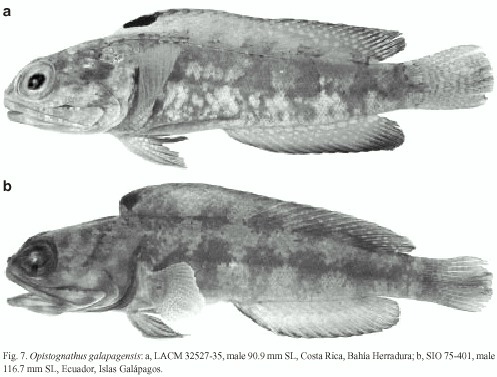
Comparative material. Nontypes of: Opistognathus fossoris, n. sp.: SIO 65-299, 28 (61.2-92.1); Mexico, Gulf of California, E. side of Isla Carmen, 25°59.2 N, 111°05.0 W; rotenone, 15-23 m, R/V Horizon, R. Rosenblatt et al.; July 13, 1965. SIO 65-321, 12 (7.5-82,8); Mexico, Gulf of California, N end of Isla Carmen, 26°04.6 N, 111°05.1 W; rotenone, 12-23 m, R/V Horizon, R. Rosenblatt et al.; 17 July 1965.
Opistognathus galapagensis Allen & Robertson, Ecuador, Galapagos Islands: SIO 75- 401, 4 (71.0-116.7); Isla Santa Cruz (Indefatigable Island) Academy Bay, 00°37.0 N, 090°22.9 W; rotenone, 2 m, Cruise UCLA W64 B. Walker and E. Hobson; February 16, 1964. SIO 77-191, (85.8); Plaza Island, 00°09.0 W; 090°09.0 W; rotenone, 6 m, CASAcc 1977-III-18 J. McCosker; March 18, 1977.
Costa Rica: LACM 32557-?, 10 (48.1- 70.9); pinnacle 1.5 mi. NO of Isla del Caño, 08°4310" N, 83°5430" W; rotenone, 31-37 m, R/V Searcher, W. Bussing et al.; March 17, 1972. LACM 32547-?, 4 (51.1-56.9); N side of Isla del Caño, 8°4315" N, 83°5307" W; rotenone, 9-15 m, R/V Searcher, W. Bussing et al.; March 14, 1972. LACM 32527-35, 2 (72.8-90.9); N side of Bahía Herradura, N of the reef, 9°3845" N, 84°4055" W; rotenone, 14-17 m, R/V Searcher, W. Bussing et al.; March 10, 1972. UCR 620-6, (64.9); 10°5127" N, 86°5515" W; rotenone, 12-18 m, R/V Searcher, W. Bussing et al.; February 16, 1972. UCR 622-3, (81.6); Islas Murciélagos, SO side of Islas Las Golondrinas, 10°5115" W; rotenone, 14-20 m, R/V Searcher, W. Bussing et al.; February 17, 1972. UCR 627-6, 2 (52.0-92.7); 10°5335" N, 85°5752" W; rotenone, 15-18 m, R/V Searcher, W. Bussing et al.; February 18, 1972. UCR 684-12, (48.3); same data as LACM 32557-?, specimen not located. UCR 689-17, (44.4); 08°4315" N, 83°5320" W; rotenone, 8-9 m, R/V Searcher, W. Bussing et al.; March 18, 1972.
TABLE 4
Proportional measurements in percent of standard length for types of Opistognathus fossoris
and holotype and nontypes of O. galapagensis
Opistognathus fenmutis Acero & Franke, 1993: 291 (orig. descr., Isla Gorgona, Colombia).
Material. LACM 45707-1, female (132); Eastern tropical Pacific, Costa Rica, Isla del Caño, 8°45 N, 83°55 W; Ex UCR 816-1, otter trawl, 74 m, collector Mario Zuñiga.
Diagnostic characters. A large (132-218) species of Opistognathus with the following combination of features: truncate caudal fin; soft dorsal rays 13, anal spines III; oblique scale rows in longitudinal series102-105; pored lateral line scales 68-73; gill rakers on lower limb of first arch 26-30. Three violet parallel lines running entire length of body on Colombian specimens (no spotting or other markings on head or body of Costa Rican specimen except for a series of small dark spots along the distal margin of dorsal fin); caudal vertebrae 16.
Description (Costa Rican specimen). Body robust and moderately deep (body depth 4.3 in SL); origin of dorsal fin on nape just behind top of gill opening (predorsal length 3.6 in SL); origin of anal fin just behind anus, which is behind midbody (preanal length 1.7 in SL). Head bluntly rounded (length 3.1 in SL); orbit moderate, its center over anterior half of upper jaw; snout short (6.2 in HL); interorbital space slightly concave, smooth (11.1 in HL), narrower than orbit (4.4 in HL). Skin texture of head rugose, strongest on snout and along the jaw margins.
Dorsal fin XI, 13; anal fin III, 13; pectoral fin 21; gill rakers 15 + 29, total 44; pored lateral-line scales 72-73 (Left/Right); precaudal vertebrae 10, total vertebrae 26; epineural ribs 15, last pleural rib on vertebra 10; no supraneural bones. Caudal fin: procurrent rays 5 + 4, segmented rays 8 + 8, middle 12 branched, total elements 25; fifth hypural present.
Scales absent on head, anterior portion of nape, area alongside dorsal spines, area above and in front of pectoral-fin bases, and breast area in front of pelvic-fin bases. Oblique scale rows in longitudinal series 105; oblique scale rows to terminus of lateral-line pores 70. Lateral line terminates below a vertical from base of third segmented dorsal-fin ray. Lateral line pores 72 or 73, arranged in a single row arising from an underlying canal through embedded lateral-line tubes; not all lateral line tubes with pores. Cephalic sensory pores moderately developed on head and nape; mandibulo-preopercular pores sparse, uniserially arranged anteriorly but clustered in small groups posteriorly. (The holotype has 102 oblique scale rows in longitudinal series and 68 pored scales in the lateral line, A. Acero, pers. com.).
Anterior nostril positioned only slightly closer to posterior nostril than to margin of upper lip, and consisting of an inconspicuous short tube with a longer posterior rim that does not reach margin of posterior nostril when depressed; height of tube about equal to maximum diameter of posterior nostril. Dorsal fin of moderate height, gradually decreasing in height to terminus of dorsal-fin spines; profile relatively uniform without change in fin height at junction of spinous and segmented rays; segmented dorsal-fin rays gradually increase in height. Dorsal-fin spines slender and straight without curved, flexible tips; all except first or second segmented dorsal-fin and anal-fin rays branched distally; outermost segmented pelvic-fin rays tightly bound to adjacent ray at its base, interradial membrane incised distally. Upper margin of operculum straight and slightly rounded posterodorsally, no subopercular flap present; posterior margin of operculum straight, inclined anteriorly; preopercle indistinct, without a free margin. No papillae on inner surface of lips.
Maxilla extends about 1.8 eye diameters behind orbit (2.2 eye diameters behind orbit in 193 mm SL Colombian holotype); maxilla widest at end and rounded; supramaxilla present, small and terminally positioned. Jaws subequal, lower slightly included. Premaxilla with an outer row of moderate canines anteriorly that become progressively smaller posteriorly and extend about one-half length of jaw, to just behind orbit; 2-3 irregular inner series of smaller teeth behind anterior 6 premaxillary teeth on each side, and 6 larger symphyseal canines behind them. Dentary with an outer row of moderate canines, slightly larger anteriorly; 1-3 irregular series of slightly smaller teeth behind outer row on anterior half of dentary. Vomer with a small patch of 9 teeth, arranged in a broad triangle. Infraorbital bones relatively slender, with moderate openings for sensory canals; third infraorbital without a suborbital shelf or extension.
Proportional measurements are in percent standard length: Head length 32.7; postorbital length 22.6; orbit diameter 7.4; bony interorbital distance 3.0; snout length 5.3; upper jaw length 24.1; maxilla width 4.7; body depth at dorsal-fin origin 23.1; body depth at anal-fin origin 21.9; caudal peduncle depth 12.3; caudal peduncle length 11.9; predorsal length 27.7; preanal length 57.9; prepectoral length 33.7; prepelvic length 31.1; pectoral fin length 16.0; pelvic fin length 19.3; caudal fin length 28.2; length 1st dorsal spine 6.3; length 5th dorsal spine 17.3; length 11th dorsal spine 16.6; length 1st anal ray 11.3; length 5 th anal ray 13.3.
Color (Costa Rican specimen). In alcohol preservative. Head and body uniformly light brown; fins dusky, lower half of caudal fin darker than upper half; pectoral fins transparent; a series of ten small dark brown blotches arranged along the distal margin of the spinous dorsal fin in the fin membrane (Fig. 8). Life coloration unknown. The striking three violet lines of the type series (186-218 mm SL) from Isla de Gorgona, Colombia not evident on the Costa Rican specimen.
Distribution. Previously known only from the type locality, Isla de Gorgona ca. 40 km off the Colombian coast at 63-72 m depth. In Costa Rica, it was collected at Isla del Caño, a small continental shelf island 16 km off southern Costa Rica. It was trawled from moderate depths, 74 meters, on flat sandy substrata. Opistognathus fenmutis is an eastern Pacific endemic, distributed on the central portion of the Cocos plate.
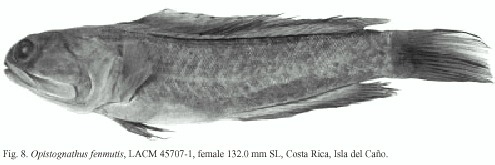
Opisthognathus punctatus Peters, 1869: 708 (orig. descr., allegedly Mazatlán, Mexico).
Opistognathus mexicanus Allen & Robertson, 1991: 47-52 (orig. descr., Gulf of California, Mexico).
The principal diagnostic characters of O. mexicanus match the coloration and morphology of juvenile specimens of O. punctatus (Fig. 9a). The major distinctions of O. mexicanus purportedly refer to its distinctive pigmentation and short maxillary length. It is true that adults of O. punctatus have "much smaller and more numerous spots, particularly on the head", than immature individuals (Fig. 9b). The statement by Allen and Robertson (1991) that " large adults of O. punctatus have a very long maxilla that is nearly equal to the head length." is only correct for males (Fig. 9d); like many sexually dimorphic jawfishes, the maxillae of adult females and young are shorter than those of large males (Fig. 9b, 9c). We also find no meristic differences between O. mexicanus and O. punctatus.
Excerpts from unpublished notes made by R. Rosenblatt on specimens representing the full size range of O. punctatus reveal pigmentary changes with growth stage:
"In general the spotting on the head is finer and more uniform than that on the body. Also the spotting is less profuse and the individual spots are larger in small individuals. The row of spots on the mandible of adults is represented in juveniles by a dusky streak which gradually breaks up into spots. Pectorals clear in juveniles, becoming increasingly spotted with increasing size. Pelvics evenly dusky in juveniles, becoming spotted in adults. Dorsal of juvenile spotted basally, dark distally with irregular rows of white spots. With increasing size the spots develop distally as well. Anal dusky, with light marking and a dark (sic.) in small juveniles, becoming increasingly spotted with increasing size. Caudal dark with white spots on rays arranged in vertical bands. Juveniles to about 150 mm with an elongate black spot on middle of dorsal between the fourth and eighth spines. In individuals smaller than about 80 mm the spot is outlined by a clear ring." Several of these markings can be recognized on the published photograph of the 82.2 mm holotype of O. mexicanus and on the 76.8 mm juvenile O. punctatus in Fig. 9a.
The type specimen of O. punctatus had a total length of 270 mm with upper jaw reaching to the base of the pectoral fins. Thus, it was an adult male. Peters described the live coloration in detail and included the two black v-shaped markings on the inner maxillary and adjacent membranes typical in males of this species (a single marking is present in females). The black buccal pigmentation of both punctatus and scops (Fig. 4b, 4c respectively) was not mentioned by Peters. The holotype of O. mexicanus has both the buccal and maxillary pigmentation typical of O. punctatus (pers. com. S. Raredon).
Thomson et al. (2000) pointed out differences in scale counts as useful in separating the two species. They cited Jordans (1883) longitudinal scale count for the type of O. punctatus as "about 125" and Allen and Robertsons "about 150" for the only type specimen of O. mexicanus. In spite of the irregularity of scale patterns on some jawfishes, it is still useful to make approximate counts. Several counts made on museum specimens at SIO and LACM varied from 128 to 152 oblique longitudinal scale rows for O. punctatus. Counts recently made on each side of the holotype of O. mexicanus were 144 and 145 (pers. com. J. Williams) and an x-ray revealed 10 + 19 vertebrae (no hypural 5), both counts typical of O. punctatus. We therefore consider O. mexicanus a junior synonym of O. punctatus.
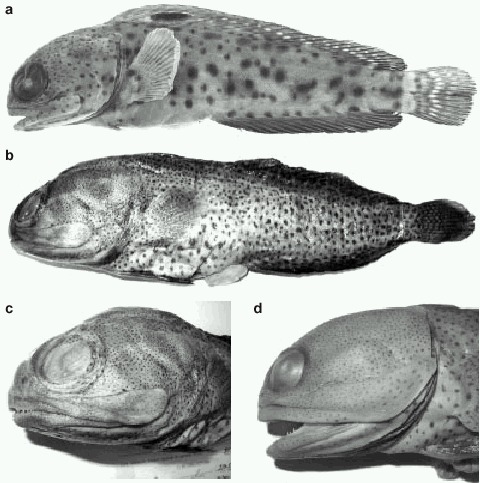
Fig. 9. Opistognathus punctatus, a, SIO 70-77, juvenile 76.8 mm SL, Mexico, Bahía de Bocachibampo; b, LACM 8850-3,
female 270.5 mm SL, Mexico, Gulf of California; c, same as 9b, closeup from different angle; d, male 201 mm SL, Mexico,
Gulf of California.
Jordan & Gilbert, 1882
This species was formerly reported only from Magdalena Bay on the outer coast of Baja California, the Gulf of California and the Revillegigedo Islands (Socorro). Collections made during the 1972 Searcher Expedition to Costa Rica yielded three specimens of O. rhomaleus from the NW side of Isla del Caño, Costa Rica:
LACM 32557-29, (69.5); (10 + 18 vertebrae), Costa Rica, Isla del Caño, pinnacle 2.4 km NW, 8°4310" N, 83°5430" W; scattered rock, coarse sand, scuba, ichthyocide, 31-37 m, R/V Searcher 482, W.A. Bussing et al., March 17, 1972. LACM 32561-19, 2 (31.5-137); (10 + 18 vertebrae), Costa Rica, same locality as LACM 32557-29; R/V Searcher 486, March 18, 1972.
Discussion
At least four species of eastern Pacific jawfish are found both at mainland and oceanic island sites. Allen and Robertson (1991) collected Opistognathus galapagensis only at the Galapagos Islands, but it also occurs along the Central American mainland. Therefore, it is not a species endemic to the Galapagos Islands. Opistognathus scops like 0. galapagensis occurs at the Galapagos Islands; O. panamaensis ranges seaward to Isla del Coco; and 0. rhomaleus is found at the Revillegigedo Islands. To our knowledge, no species of jawfish is endemic to any of the oceanic islands in the eastern Pacific.
Eastern Pacific Opistognathus may be allocated to two groups on the basis of the number of segmented dorsal-fin and anal-fin rays and presence or absence of the fifth hypural. Opistognathus brochus, walkeri, panamaensis, rosenblatti, rhomaleus and fenmutis have 11-14 dorsal and anal-fin soft rays and a fifth hypural. Opistognathus smithvanizi, fossoris, galapagensis, mexicanus, punctatus and scops have 15-17 dorsal and anal soft rays and usually no fifth hypural. Chiefly using number of anal-fin spines, gill rakers, lateral-line pores, scales, and color pattern, all of the eastern Pacific jawfishes can be distinguished from one another.
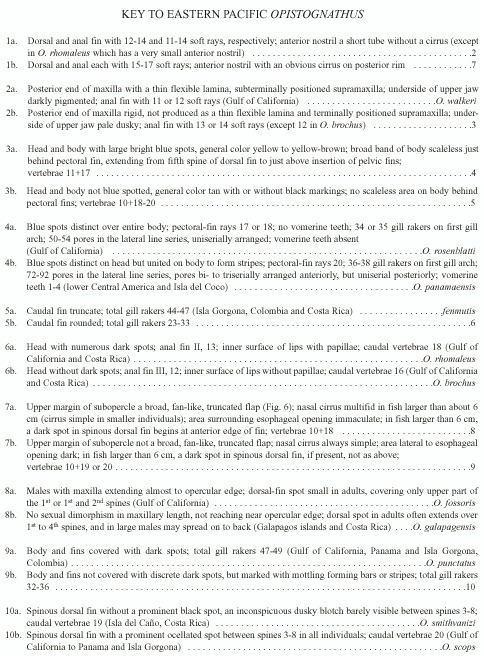
Acknowledgments
For help in gathering data and for their enthusiastic support and assistance we express our appreciation to: J.A. Seigel, R.F. Feeney, H. Schwarz, B. Rounds (LACM), and A. Acero (INVEMAR, Colombia); for allowing us access to collections and providing data on specimens: R.H. Rosenblatt, P.A. Hastings, H.J. Walker (SIO), C. Thacker, J.A. Seigel, R.F. Feeney (LACM), V. Springer, S. Jewett, J. Williams and S. Raredon (USNM); for valuable advice and criticizing the manuscript: W.F. Smith-Vaniz. For field support of eastern Pacific fish studies we acknowledge and thank the Steele Foundation, Janss Foundation, Weiler Foundation and Mrs. Margaret Taylor.
(Contribution No. 123, Museo de Zoología, Universidad de Costa Rica and Centro de Investigación en Ciencias del Mar y Limnología, CIMAR Contribution No. -)
Resumen
Tres de las cuatro especies nuevas presentan dimorfismo sexual respecto a la longitud maxilar: O. smithvanizi, con un cirro nasal sencillo, pigmentación bucal, y otras características similares a las de los miembros del grupo O. macrognathus, fue descubierto únicamente frente a la Isla del Caño, una isla de la plataforma continental de Costa Rica; O. fossoris, con un cirro nasal ramificado, una lengüeta carnosa ancha en el borde dorsal del subopérculo, y una manchita negra en las primeras puntas de la aleta dorsal, habita en el Golfo de California y es la especie-hermana de O. galapagensis; la maxila de O. walkeri termina posteriormente en una lámina delgada curva en ambos sexos, pero más pronunciada en machos, carece de cirro nasal y también es del Golfo de California. Opistognathus brochus es una especie pequeña con pocas marcas en cabeza y cuerpo, y con varias manchas oscuras a lo largo de la aleta dorsal; se encuentra en aguas medianamente profundas en la costa costarricense y en el Golfo de California. Se considera Opistognathus mexicanus como sinónimo de O. punctatus. Se informa por primera vez la presencia de O. galapagensis, O. rhomaleus y O. fenmutis en aguas costarricenses y se presenta una descripción de ese. Una clave provisional y un cuadro de características permite la identificación de todas las especies de Opistognathus conocidas en el Pacífico oriental.
References
References not cited in the text contain original descriptions of eastern Pacific jawfishes.
Acero, P.A. & R. Franke. 1993. Una nueva especie de Opistognathus (Pisces: Perciformes) para la Isla de Gorgona (Pacífico Colombiano). Caldasia 17(2): 291-293. [ Links ]
Allen, G.R. & D.R. Robertson. 1991. Quatre especes nouvelles dOpisthognathidae (Jawfishes) du Pacifique oriental tropical. Revue fr. Aquariol. 18(2): 47-52. [ Links ]
Briggs, J.C. 1974. Marine zoogeography. McGraw-Hill, New York, 475 p. [ Links ]
Castro-Aguirre, J.L. & C. Villavicencio-Garayzar. 1988. Una nueva especie de Lonchopisthus (Pisces: Perciformes: Opisthognathidae) del Golfo de California, México. An. Esc. nac. Cienc. biol., Méx. 32: 109-115. [ Links ]
Fischer, W., F. Krupp, M. Schneider, C. Sommer, K.E. Carpenter & V.H. Niem. 1995. Guía FAO para la Identificación para los Fines de la Pesca. Pacifíco Centro-oriental. Vols. 1-2: 648-1813. [ Links ]
Hastings, P.A. & D.R. Robertson. 2001. Systematics of tropical eastern Pacific fishes. Rev. Biol. Trop. 49(Suppl. 1): Preface. [ Links ]
Jenkins, O.P. & B.W. Evermann. 1889. Description of eighteen new species of fishes from the Gulf of California. Proc. U. S. Natl. Mus. 11 (698): 137-158. [ Links ]
Jordan, D.S. 1883. Notes on American fishes preserved in the museums at Berlin, London, Paris and Copenhagen. Proc. Acad. Nat. Sci. Philad. 1883(1884): 281-293. [ Links ]
Jordan, D.S. & C.H. Gilbert. 1882. List of fishes collected by Lieut. Henry E. Nichols, U.S.N., in the Gulf of California and on the west coast of Lower California, with descriptions of four new species. Proc. U.S. Nat. Mus. 4(227): 273-279. [ Links ]
Leviton, A.E., R.H. Gibbs, Jr., E. Head & C.E. Dawson. 1985. Standards in Herpetology and Ichthyology: Part 1. Standard symbolic codes for institutional resource collections in Herpetology and Ichthyology. Copeia 1983(3): 802-832. [ Links ]
López, M.I. & W.A. Bussing. 1982. Lista provisional de los peces marinos de la costa Pacífica de Costa Rica. Rev. Biol. Trop. 30: 5-26. [ Links ]
Meek, S.E. & S.F. Hildebrand. 1928. The marine fishes of Panama. Field Mus. Nat. Hist. (Zool.) 15, Part III: 709-1045. [ Links ]
Montgomery, W.L. 2002. (Obituary of) Boyd W. Walker 1917-2001. Copeia 2002: 1179-1182. [ Links ]
Peters, W.C.H. 1869. Über neue oder weniger bekannte fische des Berliner Zoologischen Museums. Monatsber. Akad. Wiss. Berlin 1869: 703-711. [ Links ]
Smith-Vaniz, W.F. 1997. Five new species of jawfishes (Opistognathus: Opistognathidae) from the Western Atlantic Ocean. Bull. Mar. Sci. 60: 1074-1128. [ Links ]
Thomson, D.A., L.T. Findley & A.N. Kerstitch. 2000. Reef fishes of the Sea of Cortez. The rocky-shore fishes of the Gulf of California. Univ. Of Texas, 353 p. [ Links ]
1 Escuela de Biología & Centro de Investigaciones en Ciencias del Mar y Limnología (CIMAR), Universidad de Costa Rica, San José, Costa Rica.
2 Natural History Museum of Los Angeles County, 900 Exposition Blvd., Los Angeles, CA 90007.













